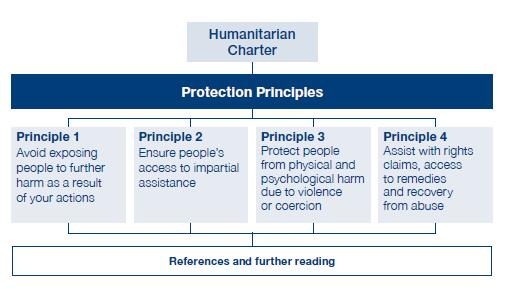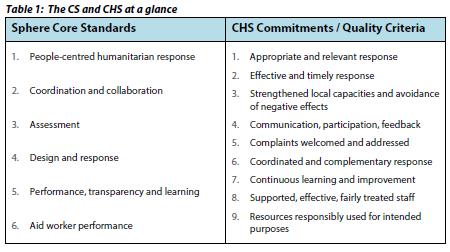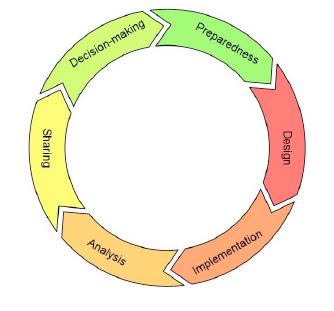Executive Summary
The Sphere Project was launched in 1997 by a group of humanitarian actors with the goal to improve the quality of their assistance and protection actions in disaster or conflict response. The underlying principle is that the affected populations have a right to life in dignity and that all steps should be taken to alleviate their suffering. The handbook published by the Sphere Project contains a Humanitarian Charter (which describes the legal responsibilities of national states to protect and assist the affected) as well as Core Standards (which provide information on general processes and frameworks for rights-based and participatory assessments). The handbook’s technical chapters include Minimum Standards for 1. Water supply, sanitation, and hygiene promotion; 2. food security, nutrition and shelter; 3. settlement and non-food items; and 4. health action. The Minimum Standards provide key standards on how to evaluate the principles, key indicators for measuring and evaluating the achievement of standards, as well as further guidance notes.
Introduction
The Sphere Project was launched in 1997 as an initiative by a group of NGOs, the International Red Cross and the Red Crescent Movement. It is based on two core beliefs: a) the protection of dignity and the right to assistance of those affected by and suffering from a disaster, a conflict or a crisis; b) salvation of people who suffer from a conflict or disaster (THE SPHERE PROJECT 2011).
The Sphere Handbook
The Sphere Project Team has published a Handbook which consists of 1) the Humanitarian Charter and 2) the Minimum Standards in Disaster Response. The Humanitarian Charter describes the legal responsibilities of national states and warring parties to protect and assist those affected. The Minimum Standards, on the other hand, consist of a set of good practices on how to respond in the event of a humanitarian crisis. In addition, the Handbook includes the following four technical chapters (THE SPHERE PROJECT 2011):
- Water supply, sanitation and hygiene promotion,
- Food security and nutrition,
- Shelter, settlement and non-food items,
- Health services.
Scope of the Sphere Handbook
The Sphere Handbook is designed to provide standards and key indicators for planning, implementation, monitoring and evaluation of humanitarian response to both slow- and rapid-onset situations following natural disasters or conflicts. They are applicable worldwide in rural and urban environments, as well as in complex political emergencies. The handbook can also be used as a negotiation tool for local and international authorities in the event of a humanitarian crisis as well as for disaster preparedness planning activities (THE SPHERE PROJECT 2011).
The Humanitarian Charter
(Adapted from THE SPHERE PROJECT 2011)
The Humanitarian Charter marks the cornerstone of the handbook and provides the ethical and legal backdrop to the protection and provision of international law in disaster response situations. It describes core principles that govern humanitarian action and sets the stage for the correct interpretation and implementation of the above. It establishes legal rights, obligations, shared beliefs and commitments of humanitarian actors and uses these to create a set of common principles, rights and duties as a statement.
The Charter identifies assistance and protection as the critical pillars of humanitarian action that are necessary to ensure basic conditions for a life with dignity. It asserts that all those affected by a disaster have a right to assistance, while recognising that those with the primary responsibility to do so are not always fully able to provide this support. The Protection Principles hence spread the responsibility for protection on all humanitarian actors that together must make sure that the most severe threats of the affected are tackled. The Charter further translates the legal principles and rights into strategies and actions.
The Core Standards
(Adapted from THE SPHERE PROJECT 2011)

Protection Principles of Humanitarian Charter. Source: THE SPHERE PROJECT (2011)
The Core Standards build the first set of standards that inform all other standards. They describe the processes and approaches which are fundamental for an effective response. They focus particularly on the capacity and active participation of the affected and provide a comprehensive analysis and understanding of the needs and context. It also offers direction for effective coordination among the involved actors.
While the Core Standards provide approaches that underpin all standards in the handbook, the Minimum Standards are qualitative and specify minimum levels for assistance in the technical areas of water supply, sanitation and hygiene promotion; food security and nutrition; shelter, settlement and non-food items as well as health services. Both, commitment to continually improving performance and employing appropriately skilled aid workers are needed to achieve these technical standards.
The Core Humanitarian Standard and the Sphere Core Standards
The general idea of the Core Humanitarian Standard on Quality and Accountability (CHS) and the Sphere Project Core Standards is to place those affected by a crisis at the core of the humanitarian response. CHS lays out the legal rights and obligations of those affected, while the Sphere Core Standards represent a practical expression of the CHS and are shown alongside the CHS core commitments in the following table (THE SPHERE PROJECT 2015a):

The Sphere Core Standards and the Core Humanitarian Standard Commitments. Source: THE SPHERE PROJECT (2015)
Sphere and the Assessment Cycle
The UN indicates that “needs assessment and analysis is the first step in Project Cycle Management, since, without this information, it is not possible to effectively implement the following steps of Strategic Planning, Resource Mobilisation, Implementation & Monitoring and Operational Review & Evaluation” (THE SPHERE PROJECT 2014). The Sphere Project addresses all stages of the project cycle (besides decision making, that is considered to lie outside the responsibility of assessment teams but rather of senior managements) (THE SPHERE PROJECT 2014).
The following figure shows the process flow through various stages of the assessment cycle.

Stages of the Assessment Cycle. Source: THE SPHERE PROJECT (2014).
Contribution of Sphere Project to Needs Assessments
A critical starting point for a successful humanitarian response through the entire project cycle is a needs assessment. The need assessments are presented in the handbook as sets of checklists at the end of each Minimum Standard. Thus, the Sphere Handbook is a valuable resource for the design and implementation of a needs assessment and also provides further analysis and monitoring tools. The approach described in the Handbook should be incorporated as much as possible into a needs assessment at every stage of the response (THE SPHERE PROJECT 2014).
Contribution of Sphere Project to Rights-based and Participatory Assessments
The Sphere Core Standards and Protection Principles set a framework for rights-based and participatory assessments. Sphere can provide a solid foundation for the entire project cycle, thereby:
- Increasing the efficiency of individual agencies and of the humanitarian community as a whole
- Improving the quality of agency programming.
- lIncreasing accountability to both affected populations and donors.
- Using Sphere indicators in assessments will help monitor key issues over time and enable assessors to develop a shared understanding of what should be assessed.
- Comparing different sectors, assessments, and projects.
- Improving coordination and collaboration, with the indicators providing a common language for identifying and discussing critical issues during assessment and project implementation both inside and outside the organisation.
- Creating a framework for data collection over time, with increasing levels of detail.
- Creating the basis for monitoring and evaluation.
Although Sphere is relevant to both sudden onset and protracted humanitarian crises, the Sphere Standards for assessments focus on sudden onset emergencies, particularly when discussing assessment implementation. However, best practice in assessments is the same regardless of the type of emergency, hence this guide is also applicable to protracted crises. A key factor is that there is more time to prepare, assessment and refine assessment processes in slow-onset crises, enabling the good practice outlined here to be incorporated more easily (THE SPHERE PROJECT 2014).
Sphere’s Contribution to Monitoring and Evaluation
(Adapted from THE SPHERE PROJECT 2015b)
In addition to the guidance for technical sectors, Sphere provides valuable support for examining the performance of the humanitarian response. This is especially valuable in situations where humanitarian actors do not have internally set targets or Standard Operating Procedures (SOP). Sphere provides two distinct types of guidance on monitoring and evaluating humanitarian action:
- Internal aspects and processes such as programming processes, systems, capacities, and performance, and
- External aspects such as the degree to which technical humanitarian standards are met.

Applications of the Sphere Project Handbook to monitoring and evaluation processes. Source: THE SPHERE PROJECT (2015).
Sphere also provides added value by emphasising on a rights-based and participatory approach. The approach described in the Handbook should be incorporated as much as possible throughout the humanitarian programme cycle.
Humanitarian Charter and Minimum Standards in Humanitarian Response
The Sphere Project is an initiative to determine and promote standards by which the global community responds to the plight of people affected by desasters. This handbook contains a humanitarian charter, protection principles and core standards in four disciplines: Water, sanitation and hygiene; food security and nutrition; shelter, settlements and non-food items; and health action.
THE SPHERE PROJECT (2011): Humanitarian Charter and Minimum Standards in Humanitarian Response. Bourton on Dunsmore: Practcal Action Publishing URL [Accessed: 31.05.2019]Sphere for Assessments. Sphere Unpacked.
The Core Humanitarian Standard and the Sphere Core Standards. Analysis and Comparison.
Sphere for Monitoring and Evaluation
Taking the initiative. Exploring quality and accountability in the humanitarian sector.
This paper is intended as a background paper for a training module. The theoretical and conceptual basis of eight of the nine different initiatives and their tools are presented as well as their linkages, both verbally and in diagrammatic form. These are presented in a short paper that would also serve as a stand-alone document, of use to two distinct audiences: policy makers and field staff.
THE SPHERE PROJECT (2009): Taking the initiative. Exploring quality and accountability in the humanitarian sector. . An introduction to eight initiatives.. Geneva: The Sphere Project URL [Accessed: 13.07.2016]The Sphere Project Evaluation Report
The evaluation reports finds that the influence of the Sphere Project in the realm of humanitarian assistance was found to be positive and widespread. The report also describes a number of areas were found where the Project could be improved. Doing so would strengthen the already important contribution that the Sphere Project has made to humanitarian assistance and would be of great benefit to those whose lives are unfortunately affected by anthropogenic or natural disasters.
VAN DYKE,M. WALDMANN, R (2004): The Sphere Project Evaluation Report. N ew York: Columbia University, Centre for Global Health and Economic Development URL [Accessed: 18.07.2016]How the Sphere Project Came into Being: A Case Study of Policy-Making in the Humanitarian Aid Sector and the Relative Influence of Research
This case study describes the process leading up to the policy shift to adopting the Sphere policy and the buy-in achieved through the first years of implementation to explore the research and policy linkages. The case study lookes at NGO performance as evaluated in terms policy impact of Sphere through the Study 3 Joint Evaluation of Emergency Assistance to Rwanda. It found that the ideas presented in the well-documented study report gave more or less immediate impetus to the embryonic Sphere project and Study 3 was regarded as impactful, highly credibly, and was seen as a very thorough piece of work. However, the impact was also partial as NGOs evaded addressing the more challenging and radical recommendations around accreditation and regulation of NGOs. The case found that research is more likely to contribute to evidence based policy if it fits within the institutional limits and pressures of policy makers, if policy makers and researchers share networks that create chains of legitimacy in policy areas, and if the outputs are based on credible evidence that are communicated appropriately.
BUCHANAN-SMITH, M. (2003): How the Sphere Project Came into Being: A Case Study of Policy-Making in the Humanitarian Aid Sector and the Relative Influence of Research. London: Overseas Development Institute URL [Accessed: 18.07.2016]Mindanao After A Month of Devastation. Philippines: Sphere Case Studies.
Potable drinking water remains a need in all areas visited however there is much more need for those who are outside evacuation centres. In Tambo in the Philippines, families affected by tropical storm WASH were hesitant a month after the storm to drink water from the faucet due to the stomach problems that they experienced. Also, the provision of drinking water has started to become scarce resulting to some people having to drink dirty water to quench their thirst.
ROY, S. 2012 (2012): Mindanao After A Month of Devastation. Philippines: Sphere Case Studies.. Geneva: The Sphere Project and Luther World Relief URL [Accessed: 18.07.2016]www.sphereproject.org/
The Sphere Project is a voluntary initiative that brings a wide range of humanitarian agencies together around a common aim in order to improve the quality of humanitarian assistance and the accountability of humanitarian actors to their constituents, donors and affected populations.
www.spherehandbook.org/
The Sphere Handbook, Humanitarian Charter and Minimum Standards in Humanitarian Response, is one of the most widely known and internationally recognized sets of common principles and universal minimum standards in life-saving areas of humanitarian response.


